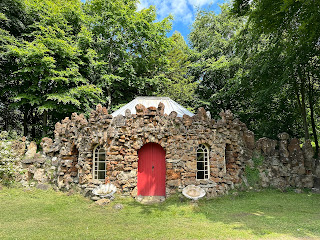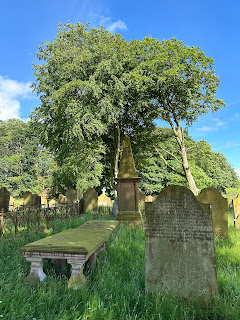Down
some narrow country lanes we drove. Down
some narrow country lanes that had never been designed for cars. Bumpy and humpy, with few passing places,
though thankfully we never met any oncoming traffic or even saw any other
vehicles at all. Through a farmstead and
then some lanes that were almost dirt tracks we drove, stopping every so often
to open gates and close gates while wondering if we were heading the right way. Was Google maps playing tricks with us? And then we saw it. A small, walled tree lined graveyard surrounded
by fields on three sides, and then some woodland on the other. This was
Dalgarnock Covenant Graveyard, which had been recommended to me when I’d asked
about atmospheric and historic graveyards near to where we were staying in
Dumfries.
On
leaving the car I made my way into the blinding afternoon sunlight and through
the heavy iron gates into the graveyard.
Above me the tall trees swayed in the warm breeze. Trees so old and tall that the branches of
one had come crashing down in a recent storm to smash some of the ancient
gravestones beneath it.
One
of the first stones I came across was, however, not that ancient. It was the Martyrs Cross which was erected in
1925 and is a memorial to fifty-seven Covenanters who died in the 17th
Century, all killed for their beliefs.
Covenanters were followers of the Presbyterian Church of Scotland who
rejected the idea of the King being the spiritual head of the church. As far as they were concerned only Jesus
Christ could be the head of their church. The name Covenanter comes from the
fact that in 1638 many of those who opposed interference in their church by the
King signed a document to this effect called the National Covenant. The Stuart kings, Charles I and later, after
the Restoration, Charles II, were not happy about their roles and their ‘divine
rights’ being called into question and saw the Covenanters as rebels. This led to many hundreds of the Covenanters
being imprisoned, transported, or executed.
Platoons of Dragoons scoured the land looking for these rebels and when
they found any, they often summarily executed them.

The Martyrs Cross
Not
far from the Martyrs Cross, there is a much older stone from just over three
hundred years ago that is dedicated to James Harkness.
Gravestone of James
Harkness
The
inscription reads -
Here lyes the body of James
Harkness in Locherben who
died 6th Dec 1723 aged 72 years
Belo this stone his dust doth ly
who in dured 28 years
porsecution by tiranny
Did him persue with eko & cry
through many a lonsome place
at last by Clavers he was tane
Sentenced for to dy
But God who for his soul took care
did him from prison bring
Because no other cause they had
But that he could not give up
With Christ his Glorious king,
and swear alligence to that beast
the duke of york, i mean.
In spite of all there hellish rage
a naturel death he died
in full asurance of his rest
with Christ eternally
James
Harkness was a local farmer who became a hero to the Covenanters, while being seen
as a notorious rebel by the ruling powers.
At the start of the persecution of the Covenanters he, and his brother
Thomas, fled to Ireland to seek refuge there.
However, they soon tired of living a life in hiding and decided they
would rather return home and fight for their cause. The brothers were soon involved in various
escapades, the most notorious of these being the rescue of nine prisoners
during the 'Enterkin Raid'. They
received information that a group of Covenanters who had been taken prisoner,
were being escorted from Dumfries to Edinburgh by twenty-eight soldiers. On their journey they would pass through the
narrow Path of Enterkin, and it was decided that the brothers would lead an ambush
there to free the prisoners. In the
attack they managed to free nine of the prisoners and killed one soldier while
wounding many others. This attack led to
a huge number of troops then descending on the area and forcing many of the
locals to help them in their search for those responsible. Lots of people were seized and imprisoned,
including James and many of those who had been involved. They were all taken to Edinburgh, tried and
found guilty, and while awaiting execution locked up in the Canongate jail. Not relishing the prospect of being hanged, the
prisoners hatched a plot for an escape.
Not a complicated plot, they just decided to saw through the bars of the
window, jump out and run away. One
night they started, and on sawing through the first bar it fell out onto the
street. They thought the game was up as
surely either the patrolling night watchmen would have heard it fall or would
find it. Luckily, the clang of it
hitting the cobbles below did not bring the watchmen, and as fate would have
it, a passerby who was sympathetic to the plight of those in the jail, saw it,
picked it up and took it away. The other
two bars were then quickly cut through, before the floorboards to the cell
above were also cut to let comrades in there out. Altogether twenty five men managed to jump
out of the window and escape into the night, including James Harkness. He managed to make it back to Ireland, where
he stayed until the persecution of the Covenanters was over. He then returned home and died there years
later as an old man.
Thomas,
unfortunately, was not so lucky. He was
captured with two friends shortly after James had escaped. He and his friends were taken to Edinburgh
where, on their arrival, a brief trial was heard. They were found guilty, sentenced to death
and an hour later were taken out and hanged.
Gravestones at Dalgarnock
The Old Font from
Dalgarnock Church
Skull and crossbones
A fallen gravestone
Detail from fallen
gravestone
Gravestone at Dalgarnock
Gravestone at Dalgarnock
View of Dalgarnock Covenant
Graveyard
Skull and crossbones
View of Dalgarnock Covenant
Graveyard
Though
the graveyard now sits on its own, this was not always the case. There was once a church and also the large
and busy village of Dalgarnock here, but that is now all gone. Why the village died I have no idea, but by
the late 18th Century no trace of it remained with the stones of the
church and houses having all been reclaimed to build walls, dykes and buildings
elsewhere.
While
walking around the graveyard I came across a rusting, ornate iron fence
separating some of the gravestones from the others. In a gap in a crumbling iron petal, I left
the Skulferatu that had accompanied me on my trip to Dalgarnock.
Rusting, ornate iron
fence
Skulferatu #135
Skulferatu #135 on a crumbling
iron petal
Skulferatu #135 on a crumbling
iron petal
Map showing the location
of Skulferatu #135
The
coordinates for the location of the Skulferatu are -
Latitude
55.224032
Longitude
-3.768752
what3words:
seatbelt.twisty.benched
I
used the following sources for information on Dalgarnock Covenant Graveyard –
Inscriptions on the Tombstones and Monuments
Erected in Memory of the Covenanters
James Gibson
1879
The Martyr Graves of Scotland
J. H. Thomson
1903




































































